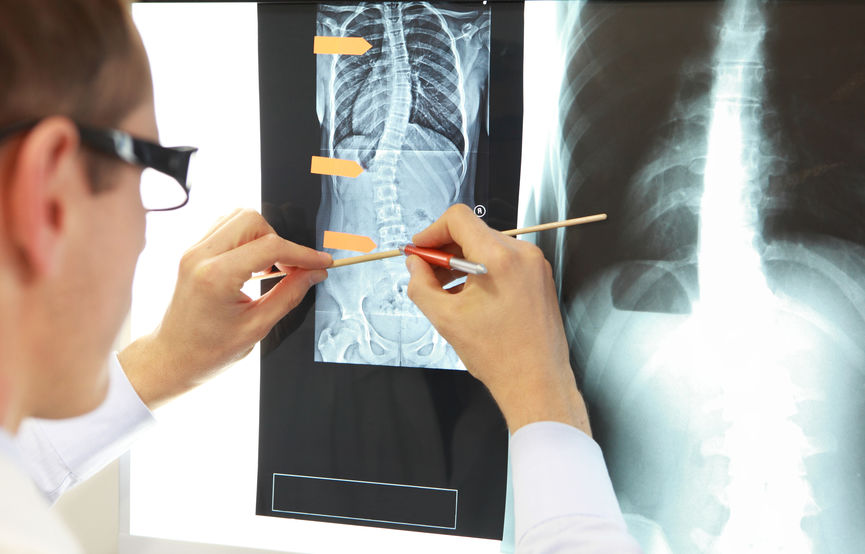The Tale of Two Scoliosis Sisters
“A trip to Disneyworld, how did that happen?” asked Julie’s excited daughter, Kate. Her older sister, Stephanie, was not as thrilled as her sister. Truth be told, Stephanie has been to Disneyworld before, but so has her sister, Kate. The newest attraction this year, Star Wars Galaxy’s Edge, is the attraction that both Stephanie and Kate were eager to experience, along with the other attractions that they loved. So why is Kate much more primed than Stephanie?

The way it happened was that Julie’s husband, Gary, finally collected enough points from their credit card purchases to land a great deal on airfare from New York and hotel accommodations, to Orlando. It was so fortunate for them that they were able to pull this family trip off. Julie, Gary and family had to make the best of the situation with each of their daughter’s scoliosis circumstances (thirty percent of scoliosis patients have a family history of scoliosis).
Both Stephanie and Kate are being treated for scoliosis. Stephanie, as the older sister, did not have the advantage that Kate had, with the new European Schroth therapy and lightweight Rigo-Chêneau Brace system. Unfortunately, at the time of Stephanie’s, scoliosis surgery, her devoted parents, were not privy to the modern European originated Rigo-Chêneau Brace and the Schroth individual therapy regiment. These two new innovations from Europe, have revolutionized and simplified most treatments to correct scoliosis in children and teenagers.
Let’s compare the two ways of treating scoliosis with Stephanie and Kate as illustrations. Stephanie’s parents were given only one option by several doctors, and that was scoliosis surgery. The surgeon, during the surgery, makes several small incisions along the child’s back. A device called a retractor is then inserted internally. The surgeon is then able to reach the spine with small tools. After that is done, some screws and rods, customized for each patient, are attached to the spine to make it straighter.

In most cases scoliosis surgery is cosmetic. Only in a few cases, when a child is younger than five years old and the lungs are not fully developed could scoliosis affect the child’s breathing. Yes, the child will have an immediate cosmetic improvement after surgery (my great niece became several inches taller post-surgery). However, there is a noticeable scar going down Stephanie’s entire back which would be called a cosmetic flaw at the pool.
An article in the American Journal of Orthopedics, published in 2015, discusses a study of 118 patients, ages 10-17 who underwent scoliosis correction surgery, a minimum of five years before. They complained of common symptoms, including occasional back pain (76%), limited range of motion (44%), activity limitations (46%), waistline imbalance (35%), rib prominence (24%), wound/scar problems (15%), and shortness of breath (15%). Physical therapy is often required after typical scoliosis surgery. Long lasting pain from both the bone graft site and shoulder pain is common after this surgery.
What is the alternative to scoliosis surgery?
Today, non-invasive methods will not only curtail the spine curvature but will reverse it. Unlike the traditional, old-fashioned scoliosis surgery, the Rigo-Chêneau Brace and Schroth therapy, have both short term and even more importantly, long term advantages over surgery. Statistics have shown that up to two out of every thousand surgeries are fatal. Almost 20% of the patients will require additional surgery within two to eight years to alleviate pain. Most of the time, there is absolutely no medical reason for surgery.
So, have you figured out why Stephanie is hesitant about going to Disneyworld?
Traveling by plane today is quite challenging for most of us. From making it on time to the airport, to making sure the luggage is the right size, most of the initial excitement of traveling is minimized this day and age. How about the issues of getting through security? While Stephanie’s siblings are already safely on the way to the gate, Stephanie is being scanned up and down her back for the permanent hardware she carries from her surgery.
Kate is also being treated for her scoliosis. She must wear a brace and do her daily exercises. However, unlike her sister, she is not in pain. She is neither subjected to countless back pinging’s by TSA security personnel. Kate will be able to wear her lightweight neatly decorated brace on the plane and she did not have to remove it before being scanned at the airport. There is no major hardware attached to it, so in most cases she will not be stopped by a beep of the security machinery. Later, in the privacy of her hotel room, she will do her required physical therapy exercises for her scoliosis.
Stephanie still must do her exercises, but her shoulder pain makes it quite unpleasant for her. Kate’s brace is lightweight and easy to clean. The brace is usually worn for about twenty-three out of twenty-four hours a day, until the person reaches bony maturity. The length of brace wearing, varies from person to person depending at what age the person stops growing. Patients are encouraged to remain active and continue activities that are important to them. Sometimes, a full twenty-three-hour regiment may not be possible.
For example, Stephanie and Kate began their vacation with a hop and jump into the pool. The brace should be removed before activities that necessitate full movements of the spine. It is not worn in the pool or shower. However, Kate will be able to wear her brace on most of the Disneyworld park rides.

Let’s join the sisters at the pool. Kate removed her Rigo-Chêneau Brace, before putting on her new bathing suit. Stephanie also has a new swimsuit. Hers, however, was specifically chosen with a high back to cover her long scoliosis surgery scar. Their mom, watched painstakingly, as the two sisters played in the pool. She noticed how much more agile Kate was than Stephanie. Before, Stephanie’s surgery, Stephanie was quite the super-diver-swimmer. Now, however, she was swimming somewhat less gracefully than Kate. When they went up to the diving board, Stephanie stood a little too straight to make a real deep dive. When she came out of the pool, her mom complimented Stephanie on her diving, but asked why she did not bend more to get a deeper dive? Stephanie admitted that her back hurts when she bends it too much.
With the girls back in the pool, several minutes later, Julie, their mom, had a chance to call the therapist at Kate’s scoliosis therapy center. First, Julie described to her how nicely Kate was doing on vacation. She wasn’t wearing the brace the full twenty-three hours, as prescribed, but she was doing her exercises quite diligently. The understanding therapist assured Julie, that if Kate was wearing her brace to sleep, and most of the waking hours of the day, things would be fine.
It was now or never. Julie mustered up her courage and asked the therapist straight out if there was anything the scoliosis center could do for her older daughter, Stephanie. The therapist explained to Julie, that new curves can crop up years after the back surgery was performed. She answered decisively, that yes, Julie, should bring Stephanie in for a scoliosis evaluation as soon as the family returned from Florida.
Progression of new curves can be reduced and eliminated by follow up appointments and continued physical therapy. If necessary, bracing treatment could be required. Julie, Stephanie’s mom, was both relieved and alarmed. She thought that treatment times with Stephanie had passed, now it seems she might need to repeat them. No, Julie, told herself, not repeat them, try new ones. Looking at the situation in a positive light, relaxed her and Julie made up her mind to start enjoying the short vacation.
Stephanie was hesitant about going on some of the more exciting rides in Disneyworld, since she did not want her back to hurt or even more frightening needing to undergo additional surgery for any minor injury caused by sudden unpredictable movements. Stephanie looked at her sister and wished she could have had the brace instead of the surgery a few years ago. Looking back, she remembered, how the doctors promised her that she will be taller and straighter with the surgery. Yes, it is true, she did become taller and straighter but the price she and her parents paid in pain and aggravation was dearer, when compared to her sister, Kate’s experience, which is so much easier and more comfortable.
We must understand that Kate’s body never had to go through the trauma of scoliosis surgery, nor will she be subjected to any surgery in the future. She is living in the same body that she was born with. She is getting long term benefits from both the custom brace that she wears for most of the day and the wonderful physical therapy that she receives. Kate’s physical and brace therapy will stop the curve from advancing, and possibly reversing it. It will also reduce both the spinal deformity and rib visibility.
Stephanie’s story is but one example of the disadvantage of scoliosis surgery. Before contemplating any back surgery for your child, make sure to explore all alternative therapies.
.


